Art & Exhibitions
Zachary Armstrong Proves You Don’t Need to Be in New York to Make It as an Artist
He's in pursuit of uninhibited creation.
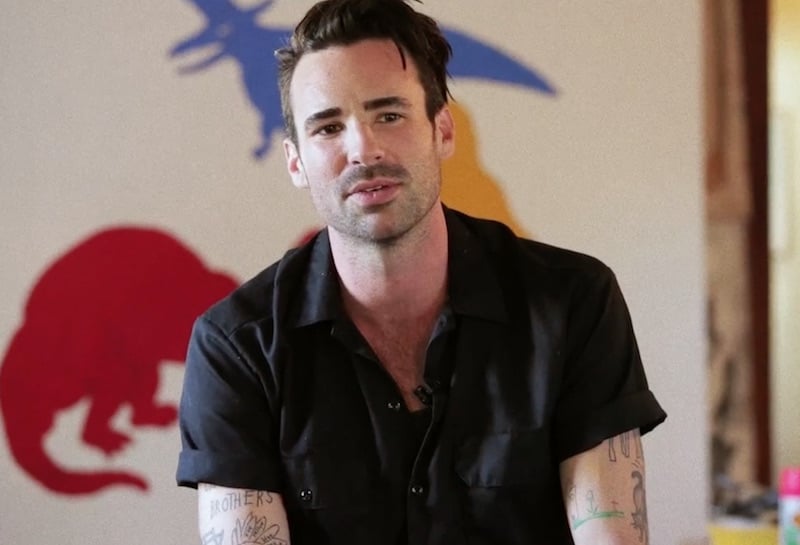
He's in pursuit of uninhibited creation.

Zachary Armstrong’s work is laden with symbolic nostalgia. The self-taught artist’s canvases on view at the Tilton Gallery on Manhattan’s Upper East Side are also reminiscent of the work of Jean Dubuffet and the outsider artists he once championed.
Armstrong is in fact somewhat of an outsider, choosing to live and work out of a studio in his hometown of Dayton, Ohio. The influence of the blue-collar city permeates his work. Compared to market darlings such as Jeff Koons, who rely on dozens of assistants, the 31-year-old artist builds all of his canvases and stretchers himself, and is known for spending marathon 16-hour sessions in the studio.
While the themes of youth and childhood occupy most of the artist’s output, stylistically he is far less consistent, dabbling in myriad painting styles and mediums. On one hand, he creates cartoonish dinosaur paintings reminiscent of children’s room wallpaper and stick figure canvases inspired by his childhood scribbles, and on the other side of the spectrum there are his vertiginous canvas stacks.
Inside his solo show at the Tilton Gallery, a childhood portrait of the artist drawn by his older brother hangs adjacent to the entrance. The picture is a recurring image throughout the show. The image is superimposed multiple times in the artist’s encaustic covered canvases. We walked through the exhibition with the artist who spoke about his hometown, his influences, and his studio practice.
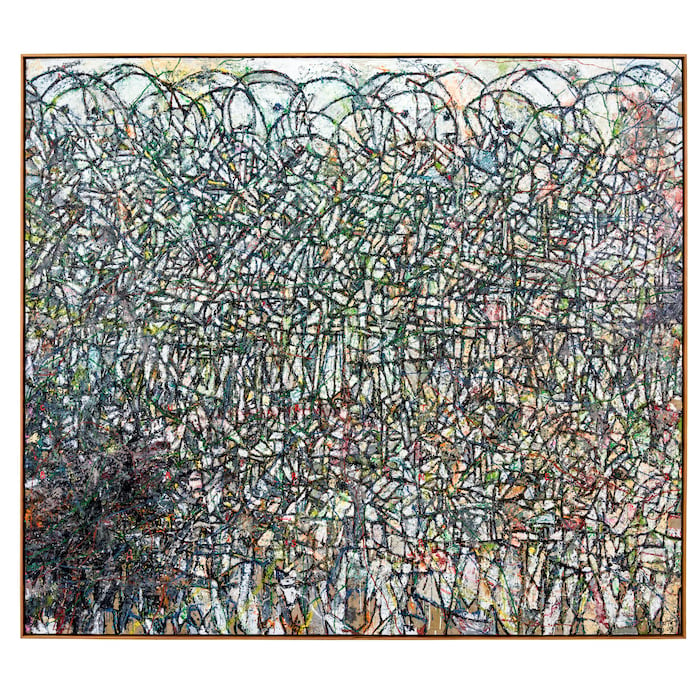
Zachary Armstrong Portrait After Noah Curtis Barnes Sr (2016) Photo: courtesy Tilton Gallery
What is your experience as a self-taught artist?
My dad was an art teacher so we just grew up drawing like crazy and there were always tons of art materials in the house… there was a ceramics studio in the house and that was it from the beginning. My brother is an artist here in New York and works as a designer. But everybody has got their hand[s] in it in one way or another.
When did you become an artist full-time?
It was really hard, but your early twenties is when everybody takes time to think about what they want to do, what they are going to do, and what makes them happy. It was a real struggle, a real broke struggle for a long time. But I just started taking it more seriously and putting…all I had into just making artwork, and slowly but surely I started to sell paintings in Ohio. And I thought, man, somebody’s paying a few thousand dollars for a painting in Ohio, maybe I am onto something, maybe I’m not crazy.
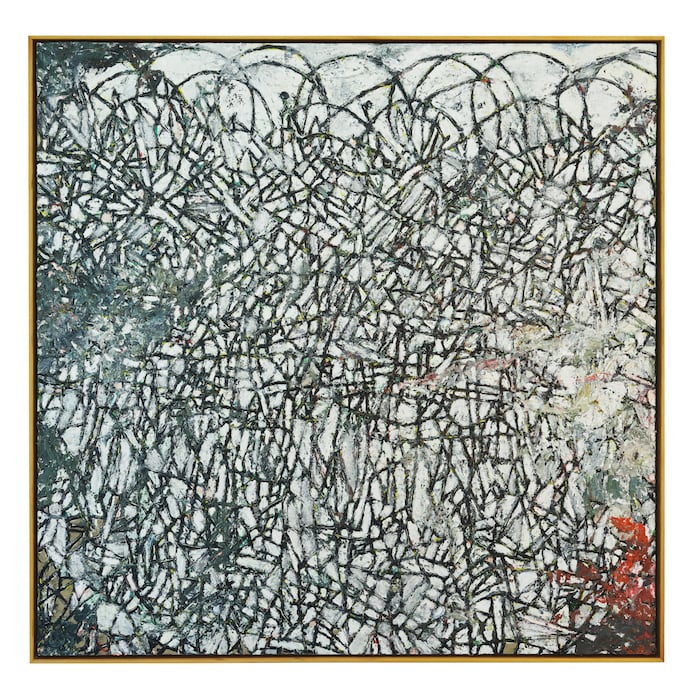
Zachary Armstrong Portrait After Noah Red Corner (2016) Photo: courtesy Tilton Gallery
Why have you chosen to stay in Ohio?
I have a little boy there. I had him when I was very young, and I always used to think that I had to leave… There’s not a network of artists or friends with shows or things like that. Now more and more I travel a lot, and I always have tried to get the hell out of Ohio to keep my sanity but the more I’m gone, the more I like it there.
I’m in New York a whole lot and have been for a while, but now I can’t wait to go home. Also, my studio is massive and so cheap, because its fucking Ohio. It’s just so affordable there, especially if you can make money from elsewhere, so I’m spoiled there, too. And its easy to do things. You can get in your truck and go to the hardware store and buy a bunch of wood and be back to work in the studio in under an hour while here [in New York] that’s a day’s mission.
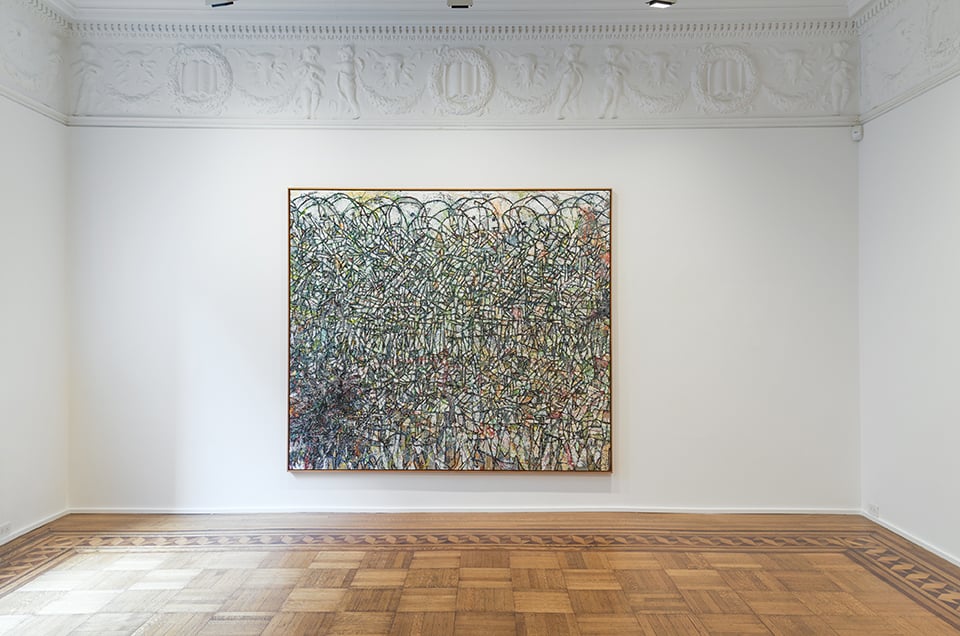
Installation view Zachary Armstrong Paintings at Tilton Gallery. Photo: courtesy Tilton Gallery
Your work has taken many forms over the years. Why the big aesthetic jumps?
I never really considered myself as a painter, just as an artist, I guess; I just want to make stuff. But after years of consistently making paintings, big paintings, and learning from them and adding and taking away and doing things then you do realize, Oh shit, I am more of a painter than I am any kind of other artist.
What’s your working process?
Another good thing about Ohio is that there’s just nothing else to do but work. You can’t go out and have a whole lot of fun at night or do anything like that. I mean, I got my little boy and he’s in the studio a lot with me too, he’s 13 now. I spend time with him and I work and that’s it.
I work every day, a minimum 10 hours a day…And that’s all I do, that’s all I want to do. Here [in New York] you can get distracted, you run an errand and half your day’s gone. But there you can literally just focus. I love that; I get up and go to work. That’s my working process [laughs].
I turn on the hot plates, let the encaustic heat up and start painting.
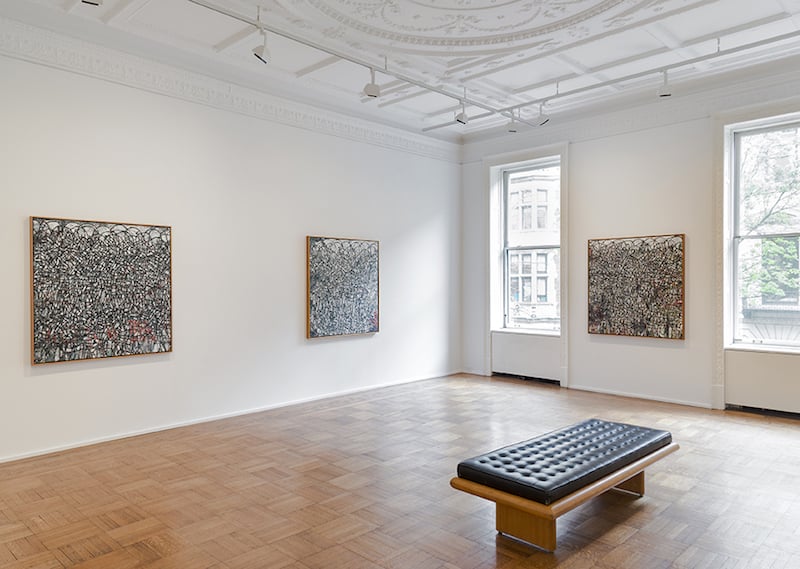
Installation view Zachary Armstrong Paintings at Tilton Gallery. Photo: courtesy Tilton Gallery
Who are some of the artists that have influenced you?
I’m always attracted to artist that I don’t make work like. For instance, I went to Chelsea last week to see the Luc Tuymans show and I love the way he paints. I like the soft, light, brushy painters. Which is the exact opposite of what these are. I saw the Michael E. Smith show, I’ve always really, really liked his work. He’s got this Midwest look, and I can read his work, maybe because we come from the same type of place.
I love big names like de Kooning, I’ve been to the Hammons show here like four, five times in the last few months. I’ve been looking at these old American painters like Gari Melchers, he made some really nice simple, early American portraits, he’s a 1900s guy who I like a lot right now.
Every couple months I’ll go through a little spurt and just go crazy buying books on somebody different, whether its someone I already know a lot about and just want to know more or [I] become more attracted to the work. In the last couple of months I’ve been buying a lot of Louise Bourgeois books…
I grew up really liking Rauschenberg and Johns and those type of guys. Growing up my dad’s favorite was probably Picasso, there were always books on him and he’s always been one of my all-time favorites.
What is it about a child-like aesthetic that appeals to you?
For whatever reason I’ve always been aware of Dubuffet, and I’m not just saying this; it sounds kind of crazy, but I never really look at him or try to learn, or look and take things away from him… People always make the relation, but Dubuffet is a little different, because he made up those things on his own. I’m almost more like a Warhol where you take a logo, you take something and you just reproduce it.
I look back at some of those early drawings and I think, fuck, I used to be able to draw so good, now I just really can’t, and now I just second guess everything. All the best drawings I did when I was young, I didn’t overthink everything. And I love that, but I can’t do that anymore and I accept that.
Hopefully you learn how to paint and what to with color and lines and how to manipulate things, so the last two years, three years that’s been happening, actually learning how to make my own marks again without being a kid anymore. To paint free-form, making those things off the top of your head, it’s hard, it takes a lot of guts, I’m jealous of artists [who] can do that.
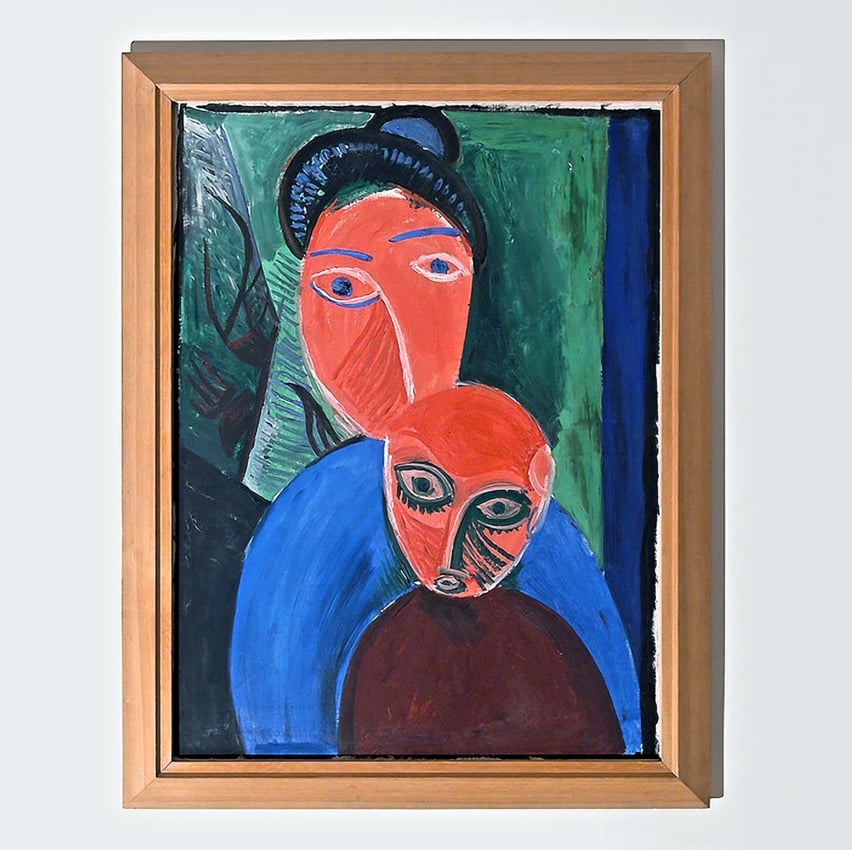
Pablo Picasso Mother and Child (1907). Photo: Pablo Picasso Collection via Facebook
If you could own any artwork from art history, what would it be and why?
I would love to have a nice Picasso mask painting.
There’s a painting I’ve always loved and lately I’ve been putting it in to these other big paintings I’ve been making. I think it’s called First Steps, from 1936. Its a painting of a mother holding a kid’s arms and the kid’s taking its first steps and she’s got this very mask-like face. It’s the way the figure takes up the canvas and the space that is one of the things that I really, really like. And it’s the way Dubuffet works too, where the whole image fits in the canvas and there’s these nice corners and borders that are negative space. It’s like he almost turned these figures into squares, or turned the figure into the shape of whatever you’re putting it on, the shape of the canvas. Dubuffet was very good at that. Everything just fits right in, the arms couldn’t go too far out, they had to be right in that square.
“Zachary Armstrong: Paintings” is on view until June 30, 2016.
This interview has been edited and condensed.